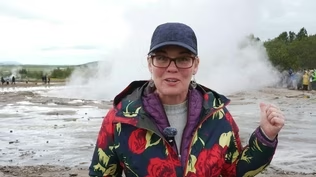But Why – A show for curious kids
Can I run on the rings of planets?
4/11/2025 | 2m 13sVideo has Closed Captions
Can I run on the rings of planets? Asks Iola from New York.
If you've ever looked out the window of a moving car and imagined yourself running along the rooftops that fly by, you might have had the same idea looking at rings around planets. From a distance they look solid, almost BUILT to be ran on, but there's more to them than meets the eye when you get up close.
Problems playing video? | Closed Captioning Feedback
Problems playing video? | Closed Captioning Feedback
But Why – A show for curious kids is a local public television program presented by Vermont Public
But Why – A show for curious kids
Can I run on the rings of planets?
4/11/2025 | 2m 13sVideo has Closed Captions
If you've ever looked out the window of a moving car and imagined yourself running along the rooftops that fly by, you might have had the same idea looking at rings around planets. From a distance they look solid, almost BUILT to be ran on, but there's more to them than meets the eye when you get up close.
Problems playing video? | Closed Captioning Feedback
How to Watch But Why – A show for curious kids
But Why – A show for curious kids is available to stream on pbs.org and the free PBS App, available on iPhone, Apple TV, Android TV, Android smartphones, Amazon Fire TV, Amazon Fire Tablet, Roku, Samsung Smart TV, and Vizio.
Providing Support for PBS.org
Learn Moreabout PBS online sponsorshipPart of These Collections
Providing Support for PBS.org
Learn Moreabout PBS online sponsorshipThere's so much in the night sky to look at.
From planets and their moons to shining stars and distant galaxies.
Every celestial object is fascinating.
But Saturn in particular is mesmerizing because of its unique rings.
They look solid, but are they?
Jupiter, Saturn, Uranus and Neptune all have rings, but Saturn's rings are the most famous, so let's use them as our example.
The rings around Saturn are made up of big chunks of ice, rock and dust floating in space.
They're kept circling around the planet by the pull of gravity, a force that attracts smaller objects to one with larger mass.
That's right.
It's not just Earth that has gravity.
Some scientists believe that the rings were formed when a giant moon made of ice broke up near Saturn.
Whatever it is that created them, the objects were pulled in while traveling through space at a rapid speed.
That speed is what keeps the rings from falling into Saturn.
Now Saturn is big.
It's nine times wider than the Earth, and the rings are absolutely gigantic.
Think about this.
Some of the objects floating in the rings might be as small as a speck of dust, but they could be as big as a bus or even a mountain.
Unfortunately, that means you can't necessarily run on the rings of planets because they're not solid.
They're made up of all of these objects.
You could, however, maybe jump from rock to rock.
You just need to figure out how to get up into space in the first place.
And then I guess charting your jumps would be pretty complicated.
You know, there may be better uses for science, but that does sound pretty fun.
To make sure you never miss But Why, like this video and subscribe to our channel and find out more at butwhykids.org

- Science and Nature

Explore scientific discoveries on television's most acclaimed science documentary series.

- Science and Nature

Capturing the splendor of the natural world, from the African plains to the Antarctic ice.












Support for PBS provided by:
But Why – A show for curious kids is a local public television program presented by Vermont Public

